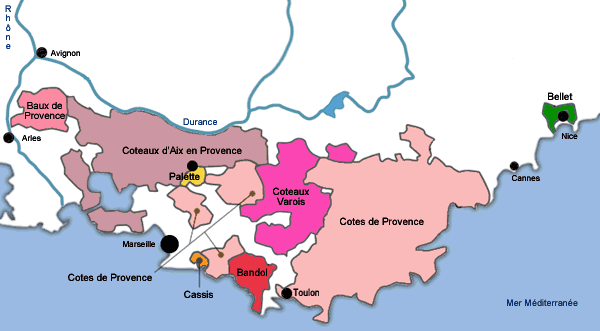You've probably noticed
the displays of rosé in your local
grocery store of wine shop. There's a sea of pink colored wine, but how
is one different from the others?
Here's a place to start.
Here's how rosé wine is made:
Nearly
all wine grapes yield clear juice. Red wine's color comes from
compounds in the grape skins that leach out into the grape juice
during a process called maceration.
Rosé is often assumed to be a sweet wine, but this is another misconception - most styles of rosé are dry.
There are a dozen or so styles of rosé,
and in this episode of Mark Rambling On About
Wine, I'm going to spotlight my favorite style,
Provence rosés.
 One easy way to spot a
Provencal rosé is by the traditional
curvy bottle, which is called a corset or a skittle. It looks like a
bowling pin.
One easy way to spot a
Provencal rosé is by the traditional
curvy bottle, which is called a corset or a skittle. It looks like a
bowling pin.
Sadly, this style of
bottle is becoming harder to find, with many Provence producers
abandoning tradition and using a style of bottle which may
look a little more familiar to consumers.
Provence lies east of
where the Rhone river meets the Mediterranean Sea. Within Provence
are several noteworthy wine regions.
Depending on which region
the wine comes from, these delicious rosés
are made with Grenache and Mourvedre, with Cinsault and Syrah also
being used depending on the specific region.
Grenache supplies
lots of fruitiness, usually strawberry and raspberry flavors, with
some definite spiciness and an inviting ruby color.
Mourvedre provides a
fuller body and floral aromas. Think violets and roses. It tastes of
plums and cherries, but also provides a savory, almost smoky, element
of dried herbs and sagebrush. These savory flavors complement
Mediterranean cuisine, think olives and grilled meat.
While an all-Grenache rosé
will be ruby red, an all-Mourvedre rosé
will be pale coral colored.
Cinsault is aromatic and
is used to soften the blend. It will supply some fruitiness, but will
also add a little nutty character.
Syrah provides bolder
strawberry and cherry flavors and a white pepper and green olive quality. See how this would pair well with Mediterranean food?
Here are a few typical Provence Rosés for you to try.
Bieler Père et Fils
Coteaux d'Aix-en-Provence
about $10 USD
This is what I would call
a “porch pounder”- easy to drink and attractively priced.
Cuvee Sabine has a pale coral
color and has floral aromas, with flavors of red berries with savory herbs de Provence thrown in. This year's rosé
is a blend of Grenache, Syrah, and Cabernet Sauvignon with a little
Cinsault and Rolle (the French name for Vermentino) thrown in.
This is a great example of
Provence rosé. Did I mention it
was only $10?
Cotes de Provence
$10 USD Here is another classic example of Provence rosé.
Ten dollars buys you a traditionally shaped bottle of salmon colored wine that tastes of strawberries with hints of watermelon. It pairs perfectly with sunshine and, perhaps, a picnic blanket.
Miradou is 40% Grenache, with 20% each of Syrah, Cinsault, and Carignan (a Spanish grape used to add color).
Chateau Gassier also makes the equally delicious Sables d'Azur.
Cotes
de Provence
$15 USD, often on sale for $11.
Along
the coast, east of Cassis, you'll find Bandol, which makes a
salmon-pink rosé of Mourvèdre,
Grenache and Cinsault. The weather here is hot, so the grapes get
very ripe, and they make a wine with high alcohol and low acid.
Bandol is a very full bodied rosé, and
if you closed
your eyes you might think that you were drinking a red wine.
Domain Sorin is located in Bandol, but not all the fruit comes from Bandol,
so their wine is labeled Cotes de Provence, the larger wine area
surrounding Bandol. This rosé is a
blend of Grenache, Mourvèdre,
Carignan, Syrah, with a handful of Ugni and Rolle (Trebbiano and
Vermentino) thrown in. Again, you get strawberries, but this time with
a nice lime tang in the finish.
Provence rosé is easy to pair with food.
For
cheese pairings, avoid stronger, aged cheeses and pair with younger
cheeses. Feta is common in Mediterranean cuisine. Look for feta made
with sheep or goat milk (or a blend of the two). Personally, I avoid
feta made with cow's milk. I think it crumbles too easily and quickly
develops a spoiled milk taste.
Pair
Provence rosé with a spinach salad
incorporating feta and sliced strawberries. The wine will pair well
with the feta and the strawberries will mirror the strawberry flavors
in the wine. An herbed vinaigrette will echo
the herbal quality of the wine.
Rosé
is a versatile food pairing wine because it contains elements of both
white and red wines without any one quality being extreme.
Rosé
goes well with grilled fish, lamb, vegetables with herbs, or stuffed
tomatoes. Rosé is equally comfortable
with Greek meze and American barbecue.
I recently
found out that Domain Sorin goes well with Korean bulgogi. I would
like to say that I determined this pairing via extensive
research, but really, one afternoon I had some leftovers in the fridge and I was
out of beer. I had half a bottle of Domain Sorin and thought “why
not?” It was delicious.
Provence
rosé pairs well with practically
everything. I like to talk about Provence rosé, but I'd rather drink it!





No comments:
Post a Comment